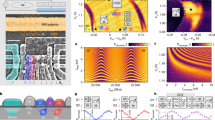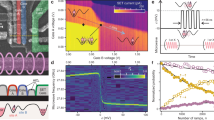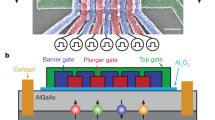Abstract
Information processing using quantum systems provides new paradigms for computation and communication and may yield insights into our understanding of the limits of quantum mechanics. However, realistic systems are never perfectly isolated from their environment, hence all quantum operations are subject to errors. Realization of a physical system for processing of quantum information that is tolerant of errors is a fundamental problem in quantum science and engineering. Here, we develop an architecture for quantum computation using electrically controlled semiconductor spins by extending the Loss–DiVincenzo scheme and by combining actively protected quantum memory and long-distance coupling mechanisms. Our approach is based on a demonstrated encoding of qubits in long-lived two-electron states, which immunizes qubits against the dominant error from hyperfine interactions. We develop a universal set of quantum gates compatible with active error suppression for these encoded qubits and an effective long-range interaction between the qubits by controlled electron transport. This approach yields a scalable architecture with favourable error thresholds for fault-tolerant operation, consistent with present experimental parameters.
This is a preview of subscription content, access via your institution
Access options
Subscribe to this journal
Receive 12 print issues and online access
$209.00 per year
only $17.42 per issue
Buy this article
- Purchase on Springer Link
- Instant access to full article PDF
Prices may be subject to local taxes which are calculated during checkout




Similar content being viewed by others
References
Loss, D. & DiVincenzo, D. Quantum computation with quantum dots. Phys. Rev. A 57, 120–126 (1998).
Makhlin, Y., Schön, G. & Shnirman, A. Quantum-state engineering with Josephson-junction devices. Rev. Mod. Phys. 73, 357–400 (2001).
Nakamura, Y., Pashkin, Y. & Tsai, J. Coherent control of macroscopic quantum states in a single-Cooper-pair box. Nature 398, 786–788 (1999).
Chiaverini, J. et al. Implementation of the semiclassical quantum Fourier transform in a scalable system. Science 308, 997–1000 (2005).
Cirac, J. I. & Zoller, P. New frontiers in quantum computation with atoms and ions. Phys. Today 57, 38–44 (2004).
Chiorescu, I., Nakamura, Y., Harmans, C. & Mooij, J. Coherent quantum dynamics of a superconducting flux qubit. Science 299, 1869–1871 (2003).
Heij, C., Dixon, D., van der Wal, C., Hadley, P. & Mooij, J. Quantum superposition of charge states on capacitively coupled superconducting islands. Phys. Rev. B 67, 144512 (2003).
Wallraff, A. et al. Strong coupling of a single photon to a superconducting qubit using circuit quantum electrodynamics. Nature 431, 162–167 (2004).
Petta, J. et al. Coherent manipulation of coupled electron spins in semiconductor quantum dots. Science 309, 2180–2184 (2005).
Duan, L.-M. & Guo, G.-C. Preserving coherence in quantum computation by pairing quantum bits. Phys. Rev. Lett. 79, 1953–1956 (1997).
Zanardi, P. & Rasetti, M. Noiseless quantum codes. Phys. Rev. Lett. 79, 3306–3309 (1997).
Lidar, D. A., Chuang, I. L. & Whaley, K. B. Decoherence-free subspaces for quantum computation. Phys. Rev. Lett. 81, 2594–2597 (1998).
Viola, L., Knill, E. & Lloyd, S. Dynamical generation of noiseless quantum subsystems. Phys. Rev. Lett. 85, 3520–3523 (2000).
Wu, L.-A. & Lidar, D. A. Creating decoherence-free subspaces using strong and fast pulses. Phys. Rev. Lett. 88, 207902 (2002).
Levy, J. Universal quantum computation with spin-1/2 pairs and Heisenberg exchange. Phys. Rev. Lett. 89, 147902 (2002).
Mohseni, M. & Lidar, D. A. Fault-tolerant quantum computation via exchange interactions. Phys. Rev. Lett. 94, 040507 (2005).
Taylor, J. M. et al. Solid-state circuit for spin entanglement generation and purification. Phys. Rev. Lett. 94, 236803 (2005).
Johnson, A. C. et al. Triplet–singlet spin relaxation via nuclei in a double quantum dot. Nature 435, 925–928 (2005).
Bracker, A. S. et al. Optical pumping of electronic and nuclear spin in single charge-tunable quantum dots. Phys. Rev. Lett. 94, 047402 (2005).
Koppens, F. H. L. et al. Control and detection of singlet-triplet mixing in a random nuclear field. Science 309, 1346–1350 (2005).
Merkulov, I. A., Efros, Al. L. & Rosen, M. Electron spin relaxation by nuclei in semiconductor quantum dots. Phys. Rev. B 65, 205309 (2002).
Khaetskii, A., Loss, D. & Glazman, L. Electron spin decoherence in quantum dots due to interaction with nuclei. Phys. Rev. Lett. 88, 186802 (2002).
de Sousa, R. & Das Sarma, S. Electron spin coherence in semiconductors: Considerations for a spin-based solid-state quantum computer architecture. Phys. Rev. B 67, 033301 (2003).
Steane, A. M. Overhead and noise threshold of fault-tolerant quantum error correction. Phys. Rev. A 68, 042322 (2003).
Devoret, M. H. & Schoelkopf, R. J. Amplifying quantum signals with the single-electron transistor. Nature 406, 1039–1046 (2000).
Lu, W., Ji, Z., Pfeiffer, L., West, K. W. & Rimberg, A. J. Real-time detection of electron tunnelling in a quantum dot. Nature 423, 422–425 (2003).
Engel, H.-A. et al. Measurement efficiency and n-shot readout of spin qubits. Phys. Rev. Lett. 93, 106804 (2004).
Ono, Y., Fujiwara, A., Nishiguchi, K., Inokawa, H. & Takahashi, Y. Manipulation and detection of single electrons for future information processing. J. Appl. Phys. 97, 031101 (2005).
Kielpinski, D., Monroe, C. & Wineland, D. Architecture for a large-scale ion-trap quantum computer. Nature 417, 709–711 (2002).
Steane, A. M. Quantum computer architecture for fast entropy extraction. Quant. Inf. Comput. 2, 297–306 (2002).
Svore, K. M., Terhal, B. M. & DiVincenzo, D. P. Local fault-tolerant quantum computation. Phys. Rev. A 72, 022317 (2005).
Petta, J. R., Johnson, A. C., Marcus, C. M., Hanson, M. P. & Gossard, A. C. Manipulation of a single charge in a double quantum dot. Phys. Rev. Lett. 93, 186802 (2004).
Khaetskii, A. V. & Nazarov, Y. V. Spin-flip transitions between Zeeman sublevels in semiconductor quantum dots. Phys. Rev. B 64, 125316 (2001).
Hanson, R. et al. Zeeman energy and spin relaxation. Phys. Rev. Lett. 91, 196802 (2003).
Monzon, F. G., Johnson, M. & Roukes, M. L. Strong Hall voltage modulation in hybrid ferromagnetic/semiconductor microstructures. Appl. Phys. Lett. 71, 3087–3089 (1997).
van der Wiel, W. G. et al. Electron transport through double quantum dots. Rev. Mod. Phys. 75, 1–22 (2003).
Shor, P. W. Scheme for reducing decoherence in quantum computer memory. Phys. Rev. A 52, R2493–R2496 (1995).
Steane, A. M. Error correcting codes in quantum theory. Phys. Rev. Lett. 77, 793–796 (1996).
Kikkawa, J. M. & Awschalom, D. D. Lateral drag of spin coherence in gallium arsenide. Nature 397, 139–141 (1999).
Brandes, T. & Vorrath, T. Adiabatic transfer of electrons in coupled quantum dots. Phys. Rev. B 66, 075341 (2003).
Barrett, S. D. & Barnes, C. H. W. Double-occupation errors induced by orbital dephasing in exchange-interaction quantum gates. Phys. Rev. B 66, 125318 (2002).
Hu, X. & Das Sarma, S. Charge fluctuation induced dephasing of exchange coupled spin qubits. Preprint at < http://arxiv.org/abs/cond-mat/0507725> (2005).
Vion, D. et al. Manipulating the quantum state of an electrical circuit. Science 296, 886–889 (2002).
Burkard, G., Loss, D. & DiVincenzo, D. P. Coupled quantum dots as quantum gates. Phys. Rev. B 59, 2070–2078 (1999).
Vandersypen, L. M. & Chuang, I. L. NMR techniques for quantum control and computation. Rev. Mod. Phys. 76, 1037–1069 (2004).
Gottesman, D. & Chuang, I. L. Demonstrating the viability of universal quantum computation using teleportation and single-qubit operations. Nature 402, 390–393 (1999).
Zhou, X., Leung, D. W. & Chuang, I. L. Methodology for quantum logic gate constructions. Phys. Rev. A 62, 052316 (2000).
Knill, E. Quantum computing with realistically noisy devices. Nature 434, 39–44 (2005).
Cohen-Tannoudji, C., Dupont-Roc, J. & Grynberg, G. Atom-Photon Interactions: Basic Processes and Applications (Wiley, New York, 1992).
Acknowledgements
We gratefully acknowledge conversations with J. Folk, A. Houck, A. C. Johnson, D. Loss and especially J. Petta. The work at Harvard was supported by ARO/ARDA, DARPA-QuIST, NSF Career award, NSF grant DMR-02-33773, Alfred P. Sloan Foundation, and David and Lucile Packard Foundation. The work at Innsbruck was supported by the ÖAW through project APART (W.D.), the European Union and the Austrian Science Foundation.
Author information
Authors and Affiliations
Corresponding author
Ethics declarations
Competing interests
The authors declare no competing financial interests.
Rights and permissions
About this article
Cite this article
Taylor, J., Engel, HA., Dür, W. et al. Fault-tolerant architecture for quantum computation using electrically controlled semiconductor spins. Nature Phys 1, 177–183 (2005). https://doi.org/10.1038/nphys174
Received:
Revised:
Accepted:
Published:
Issue Date:
DOI: https://doi.org/10.1038/nphys174
This article is cited by
-
Enhancement of persistent currents and magnetic fields in a two dimensional quantum ring
Scientific Reports (2023)
-
Probing two-qubit capacitive interactions beyond bilinear regime using dual Hamiltonian parameter estimations
npj Quantum Information (2023)
-
Exact solution for the quantum and private capacities of bosonic dephasing channels
Nature Photonics (2023)
-
Compilation and scaling strategies for a silicon quantum processor with sparse two-dimensional connectivity
npj Quantum Information (2023)
-
Universal control of a six-qubit quantum processor in silicon
Nature (2022)



